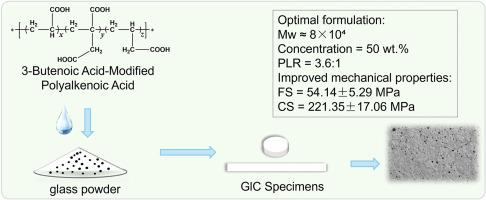Optimization of 3-butenoic acid-modified polyalkenoic acid for enhanced glass ionomer cement performance
IF 3.5
2区 医学
Q2 ENGINEERING, BIOMEDICAL
Journal of the Mechanical Behavior of Biomedical Materials
Pub Date : 2025-08-28
DOI:10.1016/j.jmbbm.2025.107177
引用次数: 0
Abstract
Objective
Glass ionomer cements (GICs) suffer from mechanical limitations due to rigid intermolecular hydrogen bonding in polyalkenoic acid (PCA) that impedes ionic cross-linking during setting. This study examined how molecular weight and solution concentration of modified polyalkenoic acid (PCA) containing 3-butenoic acid (VA) spacers at 8 mol% concentration (PCA-VA-8) influence comprehensive GIC performance.
Methods
PCA-VA-8 polymers with varying molecular weights (5.49 × 104 to 15.57 × 104) were synthesized via free radical copolymerization of acrylic acid, itaconic acid, and 3-butenoic acid by controlling initiator dosage. Experimental GICs were prepared using different PCA-VA-8 concentrations (40–60 wt%) and powder-to-liquid ratios (3.2:1 to 4.0:1). Mechanical properties were evaluated according to ISO 9917–1:2007 standards, while water sorption, solubility, aging resistance, and fluoride release were assessed over 4-week immersion periods.
Results
The optimal formulation (molecular weight ≈8 × 104, 50 wt% concentration, 3.6:1 powder-to-liquid ratio) achieved enhanced mechanical properties: flexural strength 54.14 ± 5.29 MPa, flexural modulus 19.00 ± 1.06 GPa, and compressive strength 221.35 ± 17.06 MPa (p < 0.05). This formulation showed 33 %–63 % higher flexural strength than commercial Fuji IX-GIC throughout 4-week water aging while maintaining excellent dimensional stability. Water sorption was reduced by 18 %–22 % during initial weeks compared to commercial materials, with solubility remaining comparable to controls (p > 0.05). Fluoride release analysis revealed an initial burst release of 4.1 μg/mL on day 1, followed by stabilization at 0.6–0.9 μg/mL from day 4 onward. Although lower than the initial release of commercial Fuji IX-GIC (6.2 μg/mL), the sustained fluoride levels remained above the therapeutic threshold necessary for remineralization and caries prevention.
Significance
VA-modified PCA enhances GIC mechanical properties through improved polymer chain flexibility while maintaining clinical requirements for water resistance and fluoride release, representing a promising advancement for next-generation restorative applications.

3-丁烯酸改性聚烯酸增强玻璃离子水泥性能的优化研究
目的:聚烯酸(PCA)中刚性的分子间氢键阻碍了固化过程中的离子交联,使得玻璃离子水合物(gic)的力学性能受到限制。本研究考察了含3-丁烯酸(VA)间隔剂(PCA-VA-8)的改性聚烯酸(PCA)的分子量和溶液浓度对其综合GIC性能的影响。方法通过控制引发剂用量,采用丙烯酸、衣康酸和3-丁酸自由基共聚的方法,合成了分子量为5.49 × 104 ~ 15.57 × 104的spca - va -8聚合物。采用不同的PCA-VA-8浓度(40-60 wt%)和粉液比(3.2:1至4.0:1)制备实验性gic。机械性能根据ISO 9917-1:2007标准进行评估,而吸水性,溶解度,抗老化性和氟化物释放则在4周的浸泡时间内进行评估。结果优化后的配方(分子量≈8 × 104, wt%浓度为50,粉液比为3.6:1)获得了较好的力学性能:抗弯强度54.14±5.29 MPa,抗弯模量19.00±1.06 GPa,抗压强度221.35±17.06 MPa (p < 0.05)。在4周的水老化过程中,该配方的抗弯强度比商用富士IX-GIC高33% - 63%,同时保持了优异的尺寸稳定性。与商业材料相比,在最初的几周内,吸水性降低了18% - 22%,溶解度与对照组相当(p > 0.05)。氟化物释放分析显示,第1天的初始释放量为4.1 μg/mL,从第4天开始稳定在0.6-0.9 μg/mL。虽然低于商业富士IX-GIC的初始释放量(6.2 μg/mL),但持续的氟化物水平仍高于再矿化和预防龋齿所需的治疗阈值。eva改性PCA通过提高聚合物链的柔韧性增强了GIC的机械性能,同时保持了临床对耐水性和氟化物释放的要求,代表了下一代修复应用的有希望的进步。
本文章由计算机程序翻译,如有差异,请以英文原文为准。
求助全文
约1分钟内获得全文
求助全文
来源期刊

Journal of the Mechanical Behavior of Biomedical Materials
工程技术-材料科学:生物材料
CiteScore
7.20
自引率
7.70%
发文量
505
审稿时长
46 days
期刊介绍:
The Journal of the Mechanical Behavior of Biomedical Materials is concerned with the mechanical deformation, damage and failure under applied forces, of biological material (at the tissue, cellular and molecular levels) and of biomaterials, i.e. those materials which are designed to mimic or replace biological materials.
The primary focus of the journal is the synthesis of materials science, biology, and medical and dental science. Reports of fundamental scientific investigations are welcome, as are articles concerned with the practical application of materials in medical devices. Both experimental and theoretical work is of interest; theoretical papers will normally include comparison of predictions with experimental data, though we recognize that this may not always be appropriate. The journal also publishes technical notes concerned with emerging experimental or theoretical techniques, letters to the editor and, by invitation, review articles and papers describing existing techniques for the benefit of an interdisciplinary readership.
 求助内容:
求助内容: 应助结果提醒方式:
应助结果提醒方式:


